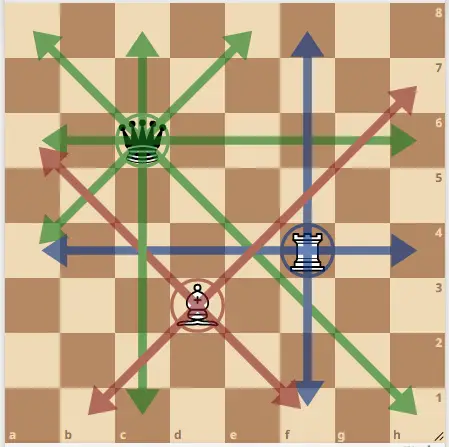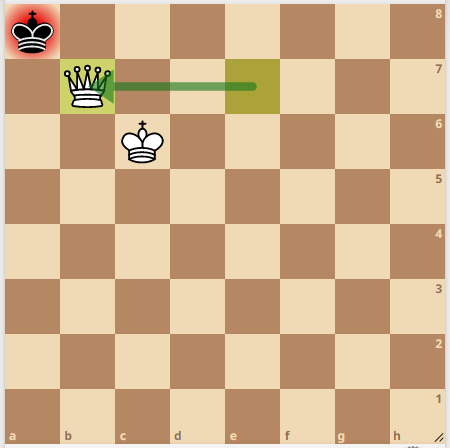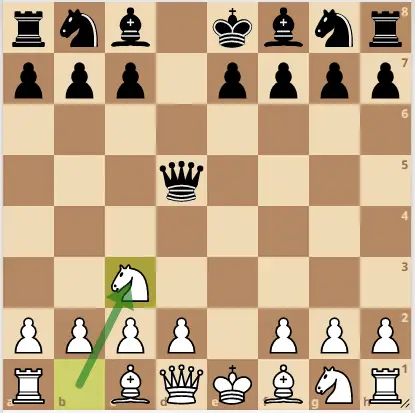The queen is said to be the most powerful piece in chess. Losing it significantly reduces the force of your army which often results in defeat.
However, many people want to know “Why is the queen so powerful?” What is it about the queen that is so destructive in chess? In this article, we will discuss the answers to those questions and share with you some tips on how to effectively make the most out of this powerful chess piece. With that said, let’s jump right in.
Here are the 4 main reasons why the queen is so powerful:
- The queen moves in any direction
- The queen can move any number of squares
- The queen is an attacking piece
- The force of the queen is enough to checkmate a lone king
1. The Queen Moves In Any Direction
The queen is so powerful because it is the only chess piece that can move in any direction. By any direction, we mean vertically, horizontally and diagonally (in a straight line). Therefore, the queen can move like a rook and bishop combined.
The Queen moves up and down like a rook, and diagonally like a bishop

The resulting value of the queen is 9 points. The queen has the highest point value in chess followed by the rook, bishop, knight and pawn respectively.
The piece values are estimates that were determined as general easy-to-remember rules of thumb based on empirical observations of many games over many years. Below is a cross table showing the value of each chess piece.
| Chess Piece Name | Chess Piece Value |
| Queen | 9 |
| Rook | 5 |
| Bishop | 3 |
| Knight | 3 |
| Pawn | 1 |
| King | N/A |
2. The Queen Moves Any Number Of Squares
The second reason why the queen is so powerful is because she can move any number of squares on the chess board.
In other words, the queen can move from one end of the board to the other across the long diagonals, files or ranks.
Due to the large scope of the queen, she is able to cause a lot of problems on the chess board. For example, the queen is able to attack several pieces at once due to the number of squares she controls.
The Queen can attack several pieces at once

The queen is not limited to a set number of squares unlike the king or knight. The king can only move one square at a time, while the knight moves 2 squares straight like a rook and then one square at a right angle.
The king and knight are known as short ranged pieces, whereas the queen is a long ranged piece. Long ranged pieces are always more powerful than short ranged pieces.
3. The Queen Is An Attacking Piece
The queen can eye up to 8 pieces at once on the chess board, making her the most attacking piece. The queen often partakes in tactical combinations over the board and can work harmoniously with the other minor pieces such as the knight and bishop to carry out an attack against the enemy king.
The queen and knight duo are one of the most attacking forces on the chess board. The trickiness of the knight coupled with the sheer power of the queen often goes unmatched.
In the position below, black is ahead in a lot of material. Even though it is still black to move, the queen and knight duo proves too strong for the black’s position. 
After 1…Kf8 2.Qxg7 Ke8 3.Qxh8 Kd7 4.Qxb8 white is just in time to stop the b2 pawn from promoting.
4. The Force Of The Queen Is Enough To Checkmate A Lone King
The force of the queen with the help of the king is powerful enough to deliver checkmate to a lone king. This usually occurs in the endgame when all the pieces have been traded off.
To checkmate a lone king using your queen, you simply need to drive the enemy king to the edge of the board. This can be achieved by using your queen to cut off squares from the enemy king move by move. Once the king is pushed to either sides of the board, march your king towards the opponent’s king and use your queen to deliver the final blow.
In the position below, white managed to drive the enemy king to the last rank of the chess board. Note that the black king cannot step over onto the 7th rank as the white queen controls those squares. The next step is for white to march his king closer to the black king.
March your king towards the opposing king to prepare checkmate.

Deliver checkmate with your queen

For more information on how to checkmate with a queen, see article: How to win chess with only a queen?
The Queen’s Weakness
So far we’ve discussed why the queen is so powerful. The queen moves in any direction any number of squares in a straight line. It’s the best piece for attacking the king and has enough force to deliver checkmate to a lone king with the help of its own king.
Though the queen is the most powerful piece in chess, she does have her weaknesses. Here are 3 weaknesses of the chess queen:
The Queen Can Easily Be Chased Away
Because the queen is so powerful, then she is also very valuable. Therefore, losing the queen will significantly reduce the force of your army. As a rule of thumb, it is advised not to bring out your queen too early in the chess game as it can easily be chased away by your opponent’s pieces. Developing your queen too early can result in loss of tempo as your opponent can attack it with one of his pieces or pawns.
When this happens, you have to move your queen away from the threat onto a safer square. The time it takes for you to move your queen away could be used to develop your other minor pieces. Time is an important element in chess. The player who develops his pieces quickly has more force and control over the position, and stands a better chance of attacking his opponent.
In the position below, black recaptured with the queen on d5 in the Scandinavian Defense Opening. The queen on d5 is immediately attacked by white’s knight on c3. The black queen is chased away from that square and now it’s white turn to move. White is said to have gained a tempo.
The black queen is forced to retreat

The Queen Is Not A Good Defender
The queen is not the ideal piece to defend another piece over the board. Not because she is incapable of defending a piece, but because she is too valuable for playing such defensive duties. Alternatively, your pawns are the best pieces for defending because losing a pawn won’t cost you much unlike losing a whole queen which is worth 9 points.
The queen should be used for attacking purposes rather than defensive purposes. Using your queen to defend another one of your pieces restricts the activity of your queen. You are not making the most out of your queen by using it to defend other pieces. This brings us to our next point…
The Queen Is Not Good At Blockading Pieces
Blockade is the action of stopping a chess piece from advancing forward. For example, a pawn that is attempting to reach the last rank and promote should be eliminated or bloackaded by the opponent’s piece. If a passed pawn gets to the last rank, then it will promote to a queen.
You can blockade this passed pawn by using one of your pieces to stop it from advancing forward. The best piece for blockading a passed pawn is your knight. This is because the knight does not lose any mobility on the blockading square. It can still jump forward at any time.
Knights are excellent blockaders of passed pawns
 The Knight is considered the best piece to block a passed pawn because its range isn’t impaired by the pawn itself. On the other hand, the queen is not the ideal piece to blokade a passed pawn. Such a defensive duty restricts the mobility of the queen as she tends over the passed pawn.
The Knight is considered the best piece to block a passed pawn because its range isn’t impaired by the pawn itself. On the other hand, the queen is not the ideal piece to blokade a passed pawn. Such a defensive duty restricts the mobility of the queen as she tends over the passed pawn.
Using a piece of lower value such as the knight is the best method of stopping passed pawns from advancing down the board. The Bishop is the second best blockader, especially if the pawn’s adjacent diagonals are open.
Should You Sacrifice The Queen?
Sacrificing your queen for a positional advantage is a known but rare strategy performed in chess, even at the top level. Some players consider sacrificing the queen as too risky of a move because you’re giving up your most powerful piece. However, there are certain positions where it calls for you to sacrfice your queen.
Here are some examples when it’s safe to sacrifice your queen:
Sacrifice your queen for 2 rooks: Indeed, you can sacrifice your queen for two rooks even though you are giving up your most valuable piece. This is because 2 rooks are worth 5+5= 10 points, whereas the queen is worth 9 points. Therefore, you’ll be up a point if your trade your queen for a pair of rooks.
Sacrifice your queen for a rook and 2 minor pieces: A minor piece is worth 3 points and the rook is worth 5 points. If we do the math, a rook and 2 minor pieces sums up to 11 points. That is 2 more points greater than the value of a single queen. It is safe to say that you should sacrifice your queen for a rook an 2 minor pieces when given the chance.
You can also sacrifice your queen for a rook, a minor piece, and few pawns, but it all depends on the characteristics of the position.
Conclusion
The queen is the strongest piece, but you can argue it’s the weakest one because if it is attacked, it has to move away since it’s the most valuable piece. As a general rule, you should develop your minor pieces before activating your queen. Developing your queen too early will result in loss of tempo. And, as we know, time is an important element in the game of chess.


